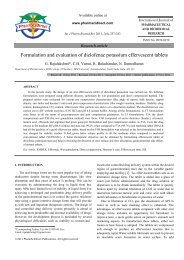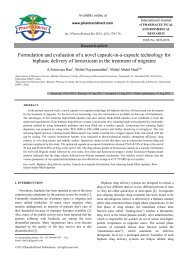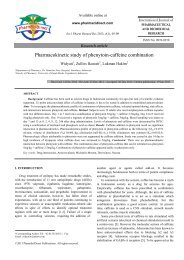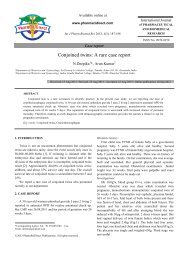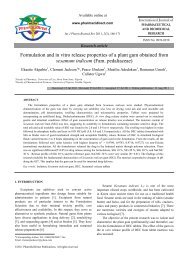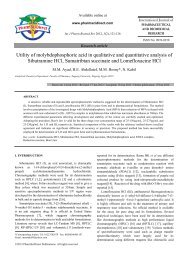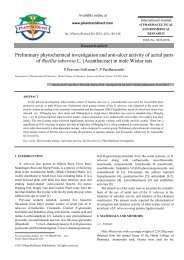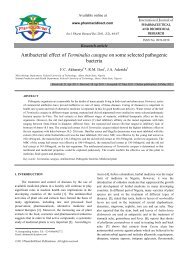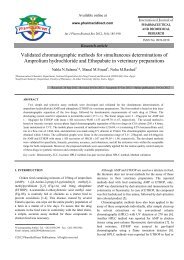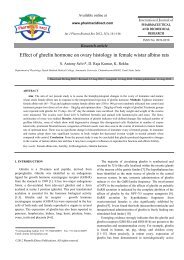Development and in vitro evaluation of mucoadhesive buccal tablets ...
Development and in vitro evaluation of mucoadhesive buccal tablets ...
Development and in vitro evaluation of mucoadhesive buccal tablets ...
Create successful ePaper yourself
Turn your PDF publications into a flip-book with our unique Google optimized e-Paper software.
Available onl<strong>in</strong>e at<br />
www.pharmscidirect.com<br />
Int J Pharm Biomed Res 2013, 4(3), 149-154<br />
Research article<br />
International Journal<br />
<strong>of</strong> PHARMACEUTICAL<br />
AND BIOMEDICAL<br />
RESEARCH<br />
ISSN No: 0976-0350<br />
<strong>Development</strong> <strong>and</strong> <strong>in</strong> <strong>vitro</strong> <strong>evaluation</strong> <strong>of</strong> <strong>mucoadhesive</strong> <strong>buccal</strong> <strong>tablets</strong> <strong>of</strong><br />
Labetalol hydrochloride<br />
Vishal Kadam*, R.P.Umbare, S.M.Patil, Vijay Chakote<br />
ASPM’S K.T.Patil College <strong>of</strong> Pharmacy, Siddharth nagar, Barshi road, Osmanabad-413 501, Maharashtra, India<br />
Received: 21 Jun 2013 / Revised: 05 Jul 2013 / Accepted: 09 Jul 2013 / Onl<strong>in</strong>e publication: 25 Jul 2013<br />
ABSTRACT<br />
The present <strong>in</strong>vestigation is concerned with development <strong>and</strong> <strong>evaluation</strong> <strong>of</strong> <strong>mucoadhesive</strong> <strong>buccal</strong> <strong>tablets</strong> conta<strong>in</strong><strong>in</strong>g<br />
antihypertensive drug, Labetalol hydrochloride to circumvent the first pass effect <strong>and</strong> to improve its bioavailability with<br />
reduction <strong>in</strong> dos<strong>in</strong>g frequency <strong>and</strong> dose related side effects. The <strong>tablets</strong> were prepared by direct compression method. 12<br />
formulations were developed us<strong>in</strong>g various concentrations <strong>of</strong> carbopol 934P as primary polymer along with any <strong>of</strong> the<br />
secondary polymers viz., HPMC K4M, sodium alg<strong>in</strong>ate, xanthan gum <strong>and</strong> guar gum. The <strong>tablets</strong> were tested for weight<br />
variation, hardness, surface pH, drug content uniformity, swell<strong>in</strong>g <strong>in</strong>dex, <strong>and</strong> bioadhesive strength <strong>and</strong> <strong>in</strong> <strong>vitro</strong> drug<br />
dissolution study. FTIR studies showed no evidence on <strong>in</strong>teractions between drug <strong>and</strong> polymers. The <strong>in</strong> <strong>vitro</strong> release <strong>of</strong><br />
Labetalol hydrochloride was performed under s<strong>in</strong>k conditions (Phosphate buffer pH 6.8, 37±0.5ºC, 50rpm) us<strong>in</strong>g USP-XXIV<br />
dissolution apparatus type II. The best <strong>in</strong> <strong>vitro</strong> drug release pr<strong>of</strong>ile was achieved with the formulation F4 which conta<strong>in</strong>s the<br />
drug, Carbopol 934P <strong>and</strong> Sodium alg<strong>in</strong>ate. The surface pH, bioadhesive strength <strong>and</strong> swell<strong>in</strong>g <strong>in</strong>dex <strong>of</strong> formulation F4 was<br />
found to be 6.53, 31.40g <strong>and</strong> 85.81%, respectively. The formulation F4, conta<strong>in</strong><strong>in</strong>g 50mg <strong>of</strong> Labetalol hydrochloride<br />
exhibited 8h susta<strong>in</strong>ed drug release i.e. 93.83% with desired therapeutic concentration. The <strong>in</strong> <strong>vitro</strong> release k<strong>in</strong>etics studies<br />
reveal that all formulations fits well with zero order k<strong>in</strong>etics followed by Korsmeyer-Peppas, first order <strong>and</strong> then Higuchi’s<br />
model <strong>and</strong> the mechanism <strong>of</strong> drug release is non-Fickian diffusion.<br />
Key words: Labetalol hydrochloride, Mucoadhesive <strong>buccal</strong> tablet, Surface pH, Bioadhesive strength, Swell<strong>in</strong>g <strong>in</strong>dex, In <strong>vitro</strong><br />
drug release<br />
1. INTRODUCTION<br />
Buccal delivery <strong>of</strong> drugs provides an attractive alternative<br />
to the oral route <strong>of</strong> drug adm<strong>in</strong>istration. Problems such as<br />
first pass metabolism <strong>and</strong> drug degradation <strong>in</strong> the GIT<br />
environment can be circumvented by adm<strong>in</strong>ister<strong>in</strong>g the drug<br />
via <strong>buccal</strong> route. Moreover, the oral cavity is easily<br />
accessible for self medication <strong>and</strong> be promptly term<strong>in</strong>ated <strong>in</strong><br />
case <strong>of</strong> toxicity by remov<strong>in</strong>g the dosage form from <strong>buccal</strong><br />
cavity [1-3]. Labetalol hydrochloride has a short biological<br />
half-life 4 to 6 hours <strong>and</strong> 50% prote<strong>in</strong> b<strong>in</strong>d<strong>in</strong>g with a daily <strong>in</strong><br />
divided doses [4]. Because <strong>of</strong> high frequency <strong>of</strong><br />
adm<strong>in</strong>istration <strong>and</strong> short biological half-life with low plasma<br />
*Correspond<strong>in</strong>g Author. Tel: +91 9730069337 Fax:<br />
Email: vishal.kadam1986@gmail.com<br />
Table<br />
©2013<br />
1<br />
PharmSciDirect Publications. All rights reserved.<br />
prote<strong>in</strong> b<strong>in</strong>d<strong>in</strong>g, Labetalol hydrochloride is an ideal drug for<br />
design<strong>in</strong>g a <strong>mucoadhesive</strong> <strong>buccal</strong> tablet for <strong>buccal</strong> delivery.<br />
Prolonged release <strong>of</strong> the drug <strong>and</strong> <strong>in</strong>creased bioavailability<br />
leads to the significant reduction <strong>in</strong> the dose <strong>and</strong> hence dose<br />
related side effects.<br />
Hence, <strong>in</strong> the present work an attempt was made to<br />
formulate <strong>mucoadhesive</strong> <strong>buccal</strong> tablet <strong>of</strong> Labetalol<br />
hydrochloride us<strong>in</strong>g different mixtures <strong>of</strong> polymers <strong>in</strong> order<br />
to avoid extensive first pass metabolism, degradation <strong>in</strong> the<br />
stomach <strong>and</strong> prolonged effect.<br />
2. MATERIALS AND METHODS<br />
2.1. Materials<br />
Labetalol hydrochloride was a gift sample from Emcure<br />
Pharmaceuticals, Pune. Carbopol 934P, HPMC K4M,
Vishal Kadam et al, Int J Pharm Biomed Res 2013, 4(3), 149-154 150<br />
Table 1<br />
Composition <strong>of</strong> Labetalol hydrochloride <strong>buccal</strong> <strong>tablets</strong><br />
Ingredients<br />
Formulation code (mg)<br />
F1 F2 F3 F4 F5 F6 F7 F8 F9 F10 F11 F12<br />
Labetalol Hcl 50 50 50 50 50 50 50 50 50 50 50 50<br />
Carbopol 934P 30 40 50 30 40 50 30 40 50 30 40 50<br />
HPMC K4M 70 60 50 - - - - - - - - -<br />
Sodium alg<strong>in</strong>ate - - - 70 60 50 - - - - - -<br />
Xanthan gum - - - - - - 70 60 50 - - -<br />
Guar gum - - - - - - - - - 70 60 50<br />
Lactose 15 15 15 15 15 15 15 15 15 15 15 15<br />
MCC 30 30 30 30 30 30 30 30 30 30 30 30<br />
Sacchar<strong>in</strong> sodium 1 1 1 1 1 1 1 1 1 1 1 1<br />
Mag. Stearate 2 2 2 2 2 2 2 2 2 2 2 2<br />
Talc 2 2 2 2 2 2 2 2 2 2 2 2<br />
Average weight 200 200 200 200 200 200 200 200 200 200 200 200<br />
sodium alg<strong>in</strong>ate, xanthan gum <strong>and</strong> guar gum were purchased<br />
from S.D.F<strong>in</strong>e Chemicals Ltd., Mumbai. All other reagents<br />
used were <strong>of</strong> analytical grade.<br />
2.2. Compatibility studies<br />
I.R spectroscopy can be used to <strong>in</strong>vestigate <strong>and</strong> predict<br />
any physiochemical <strong>in</strong>teraction between different polymers.<br />
Infrared spectra match<strong>in</strong>g approach was used for detection <strong>of</strong><br />
any possible chemical <strong>in</strong>teraction between the drug <strong>and</strong><br />
polymer. The drug-excipient compatibility studies were<br />
carried out us<strong>in</strong>g Fourier Transform Infrared<br />
Spectrophotometer (FTIR). Infra red spectra <strong>of</strong> pure drug <strong>and</strong><br />
mixture <strong>of</strong> drug <strong>and</strong> polymer were recorded.<br />
2.3. Formulation <strong>of</strong> <strong>mucoadhesive</strong> <strong>buccal</strong> <strong>tablets</strong><br />
The drug, polymers <strong>and</strong> excipients were mixed<br />
homogeneously <strong>in</strong> a glass mortar for 15 m<strong>in</strong> (Table 1). The<br />
mixture (200mg) was then compressed us<strong>in</strong>g 8mm,<br />
biconcave punch <strong>in</strong> a s<strong>in</strong>gle-stroke us<strong>in</strong>g 10-station rotary<br />
mach<strong>in</strong>e (The Rimek M<strong>in</strong>i Press-1).<br />
2.4. Evaluation <strong>of</strong> <strong>mucoadhesive</strong> <strong>buccal</strong> <strong>tablets</strong><br />
2.4.1. Weight variation<br />
Ten <strong>tablets</strong> from each formulation (F1 to F12) were<br />
weighed us<strong>in</strong>g an electronic balance <strong>and</strong> the average weight<br />
was calculated [5].<br />
2.4.2. Hardness<br />
The hardness <strong>of</strong> the <strong>tablets</strong> was determ<strong>in</strong>ed us<strong>in</strong>g<br />
Monsanto hardness tester. It is expressed <strong>in</strong> Kg/cm 2 . Three<br />
<strong>tablets</strong> were r<strong>and</strong>omly picked from each formulation <strong>and</strong> the<br />
mean <strong>and</strong> st<strong>and</strong>ard deviation values were calculated [6,7].<br />
2.4.3. Friability<br />
Roche type friabilator was used for test<strong>in</strong>g the friability.<br />
Five <strong>tablets</strong> were weighed accurately <strong>and</strong> placed <strong>in</strong> the<br />
tumbl<strong>in</strong>g apparatus that revolves at 25rpm, dropp<strong>in</strong>g the<br />
<strong>tablets</strong> through a distance <strong>of</strong> six <strong>in</strong>ches with each revolution.<br />
After 4m<strong>in</strong>, the <strong>tablets</strong> were weighed <strong>and</strong> the percentage loss<br />
was determ<strong>in</strong>ed [6,7].<br />
2.4.4. Thickness<br />
The thickness <strong>of</strong> three r<strong>and</strong>omly selected <strong>tablets</strong> from<br />
each formulation was determ<strong>in</strong>ed <strong>in</strong> mm us<strong>in</strong>g a vernier<br />
caliper (Pico India). The average values were calculated<br />
[6,7].<br />
2.4.5. Content uniformity<br />
Weigh <strong>and</strong> powder 5 <strong>tablets</strong>, weigh accurately a quantity<br />
<strong>of</strong> the powder equivalent to 50mg <strong>of</strong> Labetalol<br />
Hydrochloride, shake with 150mL <strong>of</strong> phosphate buffer<br />
pH 6.8 for 10 m<strong>in</strong>, add sufficient phosphate buffer pH 6.8 to<br />
produce 200mL <strong>and</strong> filter. Dilute 10mL <strong>of</strong> filtrate to 100mL<br />
with water <strong>and</strong> measure the absorbance <strong>of</strong> the result<strong>in</strong>g<br />
solution at maximum at about 302nm [5,6].<br />
2.4.6. Surface pH<br />
The surface pH <strong>of</strong> the <strong>buccal</strong> <strong>tablets</strong> was determ<strong>in</strong>ed <strong>in</strong><br />
order to <strong>in</strong>vestigate the possibility <strong>of</strong> any side effects <strong>in</strong> vivo.<br />
As an acidic or alkal<strong>in</strong>e pH may cause irritation to the <strong>buccal</strong><br />
mucosa, it was determ<strong>in</strong>ed to keep the surface pH as close to<br />
neutral as possible. The method adopted by Battenberg et al<br />
was used to determ<strong>in</strong>e the surface pH <strong>of</strong> the tablet. A<br />
comb<strong>in</strong>ed glass electrode was used for this purpose. The<br />
tablet was allowed to swell by keep<strong>in</strong>g it <strong>in</strong> contact with 5mL<br />
<strong>of</strong> phosphate buffer (pH 6.8) for 2h at room temperature. The<br />
pH was measured by br<strong>in</strong>g<strong>in</strong>g the electrode <strong>in</strong> contact with<br />
the surface <strong>of</strong> the <strong>tablets</strong> <strong>and</strong> allow<strong>in</strong>g it to equilibrate for<br />
1m<strong>in</strong> [8].
Vishal Kadam et al, Int J Pharm Biomed Res 2013, 4(3), 149-154 151<br />
2.4.7. Mucoadhesion studies<br />
Mucoadhesion strength <strong>of</strong> the tablet was measured on a<br />
modified physical balance employ<strong>in</strong>g the method us<strong>in</strong>g sheep<br />
<strong>buccal</strong> mucosa as model mucosal membrane [9]. Fresh sheep<br />
<strong>buccal</strong> mucosa was obta<strong>in</strong>ed from a local slaughter house <strong>and</strong><br />
was used with<strong>in</strong> 2h <strong>of</strong> slaughter<strong>in</strong>g. The mucosal membrane<br />
was washed with distilled water <strong>and</strong> then with phosphate<br />
buffer pH 6.8. A double beam physical balance was taken<br />
<strong>and</strong> to the left arm <strong>of</strong> balance a thick thread <strong>of</strong> suitable length<br />
was hanged <strong>and</strong> to the bottom side <strong>of</strong> thread a glass stopper<br />
with uniform surface was tied. The <strong>buccal</strong> mucosa was tied<br />
tightly with mucosal side upward us<strong>in</strong>g thread over the base<br />
<strong>of</strong> <strong>in</strong>verted 50mL glass beaker which was placed <strong>in</strong> a 500mL<br />
beaker filled with phosphate buffer pH 6.8 kept at 37°C such<br />
that the buffer reaches the surface <strong>of</strong> mucosal membrane <strong>and</strong><br />
keeps it moist. The <strong>buccal</strong> tablet was then stuck to glass<br />
stopper from one side membrane us<strong>in</strong>g an adhesive<br />
(Feviquick). The two sides <strong>of</strong> the balance were made equal<br />
before the study, by keep<strong>in</strong>g a weight on the right h<strong>and</strong> pan.<br />
A weight <strong>of</strong> 5g was removed from the right h<strong>and</strong> pan, which<br />
lowered the glass stopper along with the tablet over the<br />
mucosal membrane with a weight <strong>of</strong> 5g. The balance was<br />
kept <strong>in</strong> this position for 3m<strong>in</strong>. Then, the weights were<br />
<strong>in</strong>creased on the right pan until tablet just separated from<br />
mucosal membrane. The excess weight on the right pan i.e.<br />
total weight m<strong>in</strong>us 5g was taken as a measure <strong>of</strong> the<br />
<strong>mucoadhesive</strong> strength. The mean value <strong>of</strong> three trials was<br />
taken for each set <strong>of</strong> formulations. After each measurement,<br />
the tissue was gently <strong>and</strong> thoroughly washed with phosphate<br />
buffer <strong>and</strong> left for 5m<strong>in</strong> before plac<strong>in</strong>g a new tablet to get<br />
appropriate results for the formulation. After calculat<strong>in</strong>g<br />
mucoadhesion strength the force <strong>of</strong> adhesion <strong>and</strong> bond<br />
strength parameters were calculated from follow<strong>in</strong>g equations<br />
as;<br />
Force <strong>of</strong> Adhesion (N) =Mucoadhesive strength × 9.8 / 1000<br />
Bond Strength (N/m 2 ) = Force <strong>of</strong> adhesion / Surface area.<br />
paddle method was used to study the drug release from the<br />
<strong>tablets</strong>. The dissolution medium consisted <strong>of</strong> 900mL <strong>of</strong><br />
phosphate buffer (pH 6.8). The release was performed at<br />
37°C ± 0.5°C, at a rotation <strong>of</strong> speed <strong>of</strong> 50rpm. 5mL samples<br />
were withdrawn at predeterm<strong>in</strong>ed time <strong>in</strong>tervals (1 to 8h) <strong>and</strong><br />
the volume was replaced with fresh medium. The samples<br />
were filtered through Whitman filter paper No.40 <strong>and</strong><br />
analyzed for Labetalol hydrochloride after appropriate<br />
dilution by UV spectrophotometer at 302nm. The % drug<br />
release was calculated us<strong>in</strong>g the calibration curve <strong>of</strong> the drug<br />
<strong>in</strong> phosphate buffer pH 6.8.<br />
2.4.10. Release k<strong>in</strong>etic studies<br />
To f<strong>in</strong>d out the mechanism <strong>of</strong> drug release from<br />
hydrophilic matrices, the <strong>in</strong> <strong>vitro</strong> release data was treated<br />
with different k<strong>in</strong>etic models, namely zero order, first order,<br />
Higuchi <strong>and</strong> Korsemeyer-Peppas.<br />
3. RESULTS AND DISCUSSION<br />
3.1. Compatibility studies<br />
The spectral data <strong>of</strong> pure drug <strong>and</strong> various drug-polymer<br />
mixtures are presented <strong>in</strong> Fig.1-5. The results <strong>in</strong>dicate that<br />
there was no chemical <strong>in</strong>compatibility between drug <strong>and</strong><br />
polymers used <strong>in</strong> the formulation.<br />
2.4.8. Swell<strong>in</strong>g studies<br />
The swell<strong>in</strong>g <strong>in</strong>dex <strong>of</strong> the <strong>buccal</strong> tablet was evaluated <strong>in</strong><br />
phosphate buffer pH 6.8 [10]. The <strong>in</strong>itial weight <strong>of</strong> the tablet<br />
was determ<strong>in</strong>ed (W1) <strong>and</strong> then tablet was placed <strong>in</strong> 6mL<br />
phosphate buffer pH 6.8 <strong>in</strong> a petridish <strong>and</strong> then was<br />
<strong>in</strong>cubated at 37 ± 1 o C. The tablet was removed at different<br />
time <strong>in</strong>tervals (1.0, 2.0, 3.0, 4.0, 5.0, 6.0, 7.0 <strong>and</strong> 8.0h) from<br />
the Petri dish <strong>and</strong> excess water was removed carefully us<strong>in</strong>g<br />
the filter paper. The swollen tablet was then reweighed (W2)<br />
<strong>and</strong> the percentage hydration was calculated us<strong>in</strong>g the<br />
follow<strong>in</strong>g formula<br />
Percentage hydration = [(W2-W1)/ W1] ×100<br />
Fig.1. IR spectra <strong>of</strong> Labetalol Hcl<br />
2.4.9. In <strong>vitro</strong> dissolution studies<br />
The <strong>in</strong> <strong>vitro</strong> dissolution study was conducted as per the<br />
United State Pharmacopoeia (USP) XXIV. The rotat<strong>in</strong>g<br />
Fig.2. IR spectra <strong>of</strong> Labetalol Hcl, Carbopol 934P <strong>and</strong> HPMC K4M
Vishal Kadam et al, Int J Pharm Biomed Res 2013, 4(3), 149-154 152<br />
3.4. Friability test<br />
The friability test for all the formulations were done as<br />
per the st<strong>and</strong>ard procedure <strong>of</strong> Indian Pharmacopoeia. The<br />
results <strong>of</strong> the friability test were tabulated <strong>in</strong> Table 2. The<br />
data <strong>in</strong>dicates that the friability was less than 1% <strong>in</strong> all<br />
formulations.<br />
3.5. Thickness<br />
Fig.3. IR spectra <strong>of</strong> Labetalol HCl,Carbopol 934P <strong>and</strong> Sodium alg<strong>in</strong>ate<br />
The thickness <strong>of</strong> the tablet was found to be almost<br />
uniform <strong>in</strong> all formulations F1 to F12. The thickness was<br />
found to be <strong>in</strong> the range <strong>of</strong> 3.0 to 3.25mm.<br />
3.6. Drug content<br />
Percentage <strong>of</strong> drug content was found to be 95.41% to<br />
99.50%. Hence it is concluded that all the formulations are<br />
follow<strong>in</strong>g acceptable limits as per Indian Pharmacopoeia i.e.<br />
± 5%.<br />
3.7. Surface pH<br />
Fig.4. IR spectra <strong>of</strong> Labetalol HCl, Carbopol 934P <strong>and</strong> Xanthan gum<br />
Surface pH <strong>of</strong> all the formulations F1 to F12 was found to<br />
be 6.17 to 6.70, which is well with<strong>in</strong> the limit <strong>of</strong> acceptable<br />
salivary pH range <strong>of</strong> 5.6 to 7.0 (Table 2). Hence, it was<br />
concluded that all formulations could not produce any local<br />
irritation to the mucosal surface.<br />
3.8. Bioadhesive strength<br />
Fig.5. IR spectra <strong>of</strong> Labetalol HCl, Carbopol 934P <strong>and</strong> Guar gum<br />
3.2. Weight variation test<br />
The weight variation test was conducted for each batch <strong>of</strong><br />
all formulations F1 to F12 as per I.P <strong>and</strong> the results are<br />
shown <strong>in</strong> Table 2. The weight variation test for all the<br />
formulations complies with the IP limit (± 10%).<br />
3.3. Hardness test<br />
The measured hardness <strong>of</strong> the <strong>tablets</strong> <strong>of</strong> each batch <strong>of</strong> all<br />
formulations i.e. F1 to F12 were ranged between 4.5 to 5.5<br />
Kg/cm 2 <strong>and</strong> the results are shown <strong>in</strong> Table 2.<br />
The bioadhesion characteristics were affected by the<br />
concentration <strong>of</strong> the bioadhesive polymers. Increase <strong>in</strong><br />
concentration <strong>of</strong> polymer <strong>in</strong>creases bioadhesive strength <strong>of</strong><br />
formulation. The formulations (F1, F2, F3) with Carbopol<br />
934P <strong>and</strong> HPMC K4M showed the bioadhesive strengths <strong>of</strong><br />
26.60, 24.50, 23.10g, respectively. The formulations (F4, F5,<br />
F6) with Carbopol 934P <strong>and</strong> sodium alg<strong>in</strong>ate showed the<br />
bioadhesive strengths <strong>of</strong> 31.40, 29.50, 27.60g, respectively.<br />
The formulations (F7, F8, F9) with Carbopol 934P <strong>and</strong><br />
Xanthan gum showed the bioadhesive strengths <strong>of</strong> 16.20,<br />
14.60, 12.10g, respectively. The formulations (F10, F11,<br />
F13) with Carbopol 934P <strong>and</strong> Guar gum showed the<br />
bioadhesive strengths <strong>of</strong> 22.00, 19.40, 17.80g, respectively.<br />
3.9. Swell<strong>in</strong>g studies<br />
The swell<strong>in</strong>g studies were conducted for all formulations<br />
i.e. F1 to F12. All the formulations were hydrated generally<br />
by keep<strong>in</strong>g the <strong>tablets</strong> <strong>in</strong> contact with phosphate buffer pH<br />
6.8 for 1 to 8h. The highest hydration (swell<strong>in</strong>g) i.e. 85.81%<br />
was observed with the formulation F4 (Fig.6).<br />
3.10. In <strong>vitro</strong> release studies<br />
The <strong>in</strong> <strong>vitro</strong> cumulative drug release pr<strong>of</strong>ile <strong>of</strong><br />
formulations F1, F2, F3 (conta<strong>in</strong><strong>in</strong>g Carbopol 934P <strong>and</strong>
Vishal Kadam et al, Int J Pharm Biomed Res 2013, 4(3), 149-154<br />
153<br />
Table 2<br />
Physico-chemical parameters <strong>of</strong> Labetalol hydrochloride <strong>buccal</strong> <strong>tablets</strong><br />
Formulation code (mg) Average weight Hardness (Kg/cm 2 ) Friability (%)<br />
F1<br />
F2<br />
F3<br />
F4<br />
F5<br />
F6<br />
F7<br />
F8<br />
F9<br />
F10<br />
F11<br />
F12<br />
198.5±0.2<br />
4.7± 0.10<br />
199.1±0. 1 4.5± 0.05<br />
198.7±0.4<br />
4.6± 0.06<br />
199.0±0.2<br />
4.8± 0.04<br />
200.2±0.22 5.3± 0.07<br />
198.8±0. 6 5.1± 0.03<br />
201.2±0.4<br />
4.6± 0.02<br />
199.3±0. 3 4.5± 0.03<br />
200.1±0. 1 4.8± 0.05<br />
199.4±0.2<br />
5.5± 0.07<br />
198.7±0. 7 5.2± 0.06<br />
199.3±0. 3 4.8± 0.04<br />
0.61<br />
0.40<br />
0.71<br />
0.50<br />
0.70<br />
0.50<br />
0.70<br />
0.40<br />
0.60<br />
0.51<br />
0.51<br />
0.81<br />
Thickness (mm) Surface pH<br />
3.00±0.02<br />
3.06±0.01<br />
3.12±0.02<br />
3.16±0.06<br />
3.25±0.05<br />
3.10±0.04<br />
3.02±0.02<br />
3.00±0.01<br />
3.10±0.03<br />
3.13±0.05<br />
3.20±0.03<br />
3.10±0.04<br />
6.30<br />
6.25<br />
6.34<br />
6.53<br />
6.40<br />
6.41<br />
6.24<br />
6.17<br />
6.29<br />
6.65<br />
6.70<br />
6.55<br />
Drug content<br />
99.24<br />
95.41<br />
99.50<br />
96.87<br />
97.71<br />
98.47<br />
96.45<br />
98.98<br />
95.97<br />
97.33<br />
98.41<br />
97.07<br />
Mucoadhesive<br />
strength<br />
26.60±0.10<br />
24.50±0.15<br />
23.10±0.21<br />
31.40±0.16<br />
29.50±0.20<br />
27.60±0.25<br />
16.20±0.10<br />
14.60±0.23<br />
12.10±0.15<br />
22.00±0.20<br />
19.40±0.30<br />
17.80±0.27<br />
Fig.6. Percentage swell<strong>in</strong>g <strong>of</strong> <strong>mucoadhesive</strong> Labetalol Hcl <strong>buccal</strong> <strong>tablets</strong><br />
100<br />
90<br />
Cumulative % drug release<br />
Cumulative % drug release<br />
Percent weight change<br />
80<br />
70<br />
60<br />
50<br />
40<br />
30<br />
20<br />
10<br />
0<br />
0 1 2 3 4 5 6 7 8 9<br />
Time <strong>in</strong> hours<br />
Fig.7. In <strong>vitro</strong> drug releasee pr<strong>of</strong>ile <strong>of</strong> formulations F1 to F3<br />
100<br />
90<br />
80<br />
70<br />
60<br />
50<br />
40<br />
30<br />
20<br />
10<br />
0<br />
F1 F2 F3 F4 F5 F6 F7 F8 F9 F10 F11 F12<br />
Formulation code<br />
90<br />
80<br />
70<br />
60<br />
50<br />
40<br />
30<br />
20<br />
10<br />
0<br />
0 1 2 3 4 5 6 7 8<br />
Time <strong>in</strong> hours<br />
Fig.8. In <strong>vitro</strong> drug releasee pr<strong>of</strong>ile <strong>of</strong> formulations F4 to F6<br />
F1<br />
F2<br />
F3<br />
F4<br />
F5<br />
F6<br />
9<br />
HPMC K4M) showed 84.17% %, 82.34%, 77.22%, respectively<br />
(Fig.7). Among these three formulations, F1 was found<br />
to be<br />
highest<br />
percentage<br />
drug release. Similarly,<br />
<strong>in</strong> <strong>vitro</strong><br />
cumulative drug<br />
release pr<strong>of</strong>ile <strong>of</strong> formulations F4, F5, F6<br />
(conta<strong>in</strong><strong>in</strong>g Carbopol 934P <strong>and</strong> sodium<br />
alg<strong>in</strong>ate) showed<br />
93.83%, 90.02% %, 86.78%, respectively (Fig.8). Among these<br />
three formulations, F4 was found to be highest percentage<br />
drug release. Dur<strong>in</strong>g the study, it was observed that the tablet<br />
formulations F1-F6 <strong>in</strong>itially swell <strong>and</strong> non-erodible over the<br />
period <strong>of</strong> 8h. The <strong>in</strong> <strong>vitro</strong> cumulative drug<br />
release pr<strong>of</strong>ile <strong>of</strong><br />
formulations F7, F8, F9 (conta<strong>in</strong><strong>in</strong>g Carbopol 934P<br />
<strong>and</strong><br />
xanthum<br />
gum) showed 78.27%, 75.96%, 71.07%,<br />
respectively (Fig.9). Among these three formulations, F7 was<br />
found to be highest percentage drug release. The <strong>in</strong> <strong>vitro</strong><br />
cumulative drug release pr<strong>of</strong>ile <strong>of</strong> formulations F10,<br />
F11,<br />
F12 (conta<strong>in</strong><strong>in</strong>g<br />
Carbopol 934P <strong>and</strong> guar gum) showed<br />
82.76%, 78.69%, 75.69%, respectively (Fig.10). Among<br />
these three formulations, F10 was found to be highest<br />
percentage drug<br />
release. It was concludedd that by <strong>in</strong>creas<strong>in</strong>g<br />
the<br />
concentration <strong>of</strong> Carbopol 934P <strong>in</strong> the formulation, the<br />
drug release rate from the <strong>tablets</strong> was found to be decreased.<br />
But when the concentration <strong>of</strong> secondary polymers <strong>in</strong>creased,<br />
the<br />
drug releasee rate was found to be <strong>in</strong>creased. This may be<br />
due to <strong>in</strong>creased hydration or swell<strong>in</strong>g characteristics <strong>of</strong><br />
polymers with <strong>in</strong>creased concentrations.<br />
From the overall<br />
data it was found that the formulation<br />
F4 showed the<br />
maximum percentage <strong>of</strong> drug<br />
release i.e. 93.83% at the end<br />
<strong>of</strong><br />
8h.<br />
3.11. Drug release k<strong>in</strong>etics<br />
In <strong>vitro</strong> drug<br />
release data <strong>of</strong> F1 to F12 were fitted to<br />
zero<br />
order, first order, Higuchi <strong>and</strong> Korsmeyer-Peppas equations<br />
to ascerta<strong>in</strong> the pattern <strong>of</strong> drug release. The R 2 values<br />
were<br />
found to be higher <strong>in</strong> zero-order <strong>and</strong> then Higuchi, which <strong>in</strong>dicates all the<br />
followed by Korsmeyer-<br />
Peppas, first order<br />
formulations followed zero-order release pattern. Accord<strong>in</strong>g<br />
to Korsmeyer-Peppas equation, the release exponent “n”<br />
value is > 0.5, which <strong>in</strong>dicates the mechanism <strong>of</strong> drug release<br />
for<br />
all formulations is non-Fickian diffusion type.
Vishal Kadam et al, Int J Pharm Biomed Res 2013, 4(3), 149-154 154<br />
Cumulative % drug release<br />
Cumulative % drug release<br />
100<br />
90<br />
80<br />
70<br />
60<br />
50<br />
40<br />
30<br />
20<br />
10<br />
0<br />
100<br />
90<br />
80<br />
70<br />
60<br />
50<br />
40<br />
30<br />
20<br />
10<br />
0<br />
0 1 2 3 4 5 6 7 8 9<br />
Time <strong>in</strong> hours<br />
Fig.9. In <strong>vitro</strong> drug release pr<strong>of</strong>ile <strong>of</strong> formulations F7 to F9<br />
0 1 2 3 4 5 6 7 8 9<br />
Time <strong>in</strong> hours<br />
Fig.10. In <strong>vitro</strong> drug release pr<strong>of</strong>ile <strong>of</strong> formulations F10 to F12<br />
4. CONCLUSIONS<br />
Mucoadhesive <strong>buccal</strong> <strong>tablets</strong> <strong>of</strong> Labetalol HCl could be<br />
prepared us<strong>in</strong>g Carbopol 934P as primary polymer <strong>in</strong><br />
comb<strong>in</strong>ation <strong>of</strong> secondary polymers such as HPMC K 4M,<br />
sodium alg<strong>in</strong>ate, xanthan gum <strong>and</strong> guar gum by direct<br />
compression method. IR spectroscopic studies <strong>in</strong>dicated that<br />
there was no drug-polymer <strong>and</strong> polymer-polymer <strong>in</strong>teraction.<br />
F7<br />
F8<br />
F9<br />
F10<br />
F11<br />
F12<br />
All the prepared <strong>tablets</strong> were <strong>in</strong> acceptable range <strong>of</strong> weight<br />
variation, hardness, thickness, friability <strong>and</strong> drug content as<br />
per pharmacopoeial specification. The <strong>buccal</strong> <strong>tablets</strong> showed<br />
good swell<strong>in</strong>g upto 8h <strong>in</strong> phosphate buffer pH 6.8<br />
ma<strong>in</strong>ta<strong>in</strong><strong>in</strong>g the <strong>in</strong>tegrity <strong>of</strong> formulation which is required for<br />
bioadhesion. The <strong>in</strong>crease <strong>in</strong> concentration <strong>of</strong> secondary<br />
polymer significantly <strong>in</strong>creases the swell<strong>in</strong>g. The surface pH<br />
<strong>of</strong> prepared <strong>buccal</strong> <strong>tablets</strong> was <strong>in</strong> the range <strong>of</strong> salivary pH,<br />
suggested that prepared <strong>tablets</strong> could be used without risk <strong>of</strong><br />
mucosal irritation. It can be seen that by <strong>in</strong>creas<strong>in</strong>g the<br />
concentration <strong>of</strong> Carbopol 934P <strong>in</strong> the formulation, the drug<br />
release rate from the <strong>tablets</strong> was found to be decreased. But<br />
when the concentration <strong>of</strong> secondary polymer <strong>in</strong>creased, the<br />
drug release rate was found to be <strong>in</strong>creased.<br />
ACKNOWLEDGEMENTS<br />
Authors wish to thank K.T. Patil College <strong>of</strong> Pharmacy,<br />
Osmanabad, Maharashtra, for provid<strong>in</strong>g research laboratory<br />
to carry out this project work.<br />
REFERENCES<br />
[1] Nakhat, P.D., Kondawar, A.A., Babla, I.B., Rathi, L.G., Yeole, P.G.,<br />
Indian J Pharm Sci 2007, 69, 505-510.<br />
[2] Mohire, N.C., Yadav, A.V., J Pharm Res 2010, 3, 650-657.<br />
[3] Verma, S., Kaul, M., Rawat, A., Sa<strong>in</strong>i, S., Int J Pharm Sci Res 2011, 2,<br />
1303-1321.<br />
[4] Ganesh, G.N.K., Pallaprola, M., Gowthamarajan, K.K., Kumar, S.,<br />
Senthil, V., Jawahar, N., Vankatesh, N., Int J <strong>of</strong> Pharm Res <strong>and</strong> Dev<br />
2011, 3, 37-49.<br />
[5] Indian Pharmacopoeia, Government <strong>of</strong> India, M<strong>in</strong>istry <strong>of</strong> Health <strong>and</strong><br />
Family Welfare, Controller <strong>of</strong> Publications, New Delhi, 1996.<br />
[6] The USP Convention Inc., CD-2004; USP27-NF.<br />
[7] Lachman, L., Liberman, H.A., Kanig, J.L., The Theory <strong>and</strong> Practice <strong>of</strong><br />
Industrial Pharmacy, 3 rd Edn., Varghese Publication House, Bombay<br />
1991.<br />
[8] Bhanja, S., Ellaiah, P., Martha, S.K., Tiwari, S.P., Das, D., Int J Pharm<br />
Biomed Res 2010, 1, 129-134.<br />
[9] Patel, V.M., Prajapati, B.G., Patel, J.K., Patel, M.M.., AAPS Pharm Sci<br />
Tech 2007, 8, 1.<br />
[10] Ramana, M.V., Nagda, C., Himaja M., Ind J Pharm Sci 2007, 69, 515-<br />
518.



